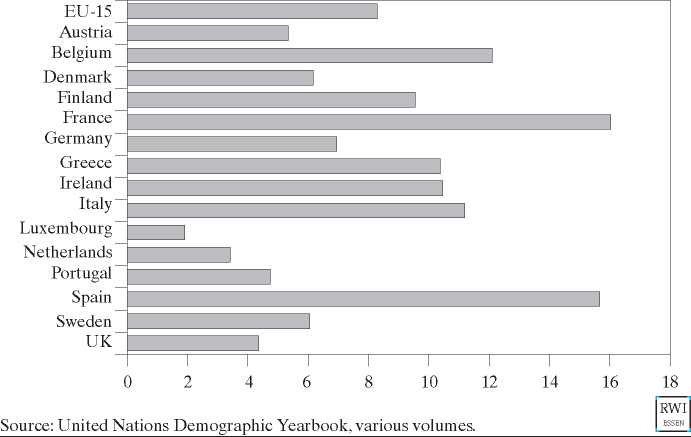Gerontocracy in Motion?
13
Figure 4
Unemployment Rates of 20-40 Year Olds in EU-15 Countries
1998; %

France, Germany and the UK). Figure 4 depicts unemployment rates for the
economically most active group of 20-40 year olds as reported by the ILO 1.In
many European countries these rates exceed 10 %, indicating a large excess
supply of labor. However, at the same time we also observe considerable ex-
cess demand for specific kinds of labor in some sectors and countries (e.g.
Zimmermann et al. 2002 for the case of Germany). This excess demand mainly
applies to higher qualification levels, though. Consequently, ifwe do not want
to miss out on a crucial labor market aspect, our discussion needs to address
the issue of qualification and skills as well.
A sizeable macroeconomic literature analyses the causes for the European
unemployment problem, attempting to isolate the roles played by institutions
and country-specific adverse shocks, and by the interactions between these
two. The most promising empirical attempts take an explicit cross-country
perspective, and relate outcomes to candidate explanatory factors such as
union power and corporatism, labor law, and the system of unemployment
support (an early seminal paper is Calmfors, Driffill 1988, another seminal
contribution is Nickell 1997). In their analysis of European cross-country data,
Blanchard/Wolfers (2000) augment the approach of Nickell (1997) by consid-
1 Data from the ILO Laborsta Database (www.laborsta.ilo.org).
More intriguing information
1. The name is absent2. Conditions for learning: partnerships for engaging secondary pupils with contemporary art.
3. Impacts of Tourism and Fiscal Expenditure on Remote Islands in Japan: A Panel Data Analysis
4. The name is absent
5. The name is absent
6. From Communication to Presence: Cognition, Emotions and Culture towards the Ultimate Communicative Experience. Festschrift in honor of Luigi Anolli
7. The geography of collaborative knowledge production: entropy techniques and results for the European Union
8. The name is absent
9. Should Local Public Employment Services be Merged with the Local Social Benefit Administrations?
10. The name is absent